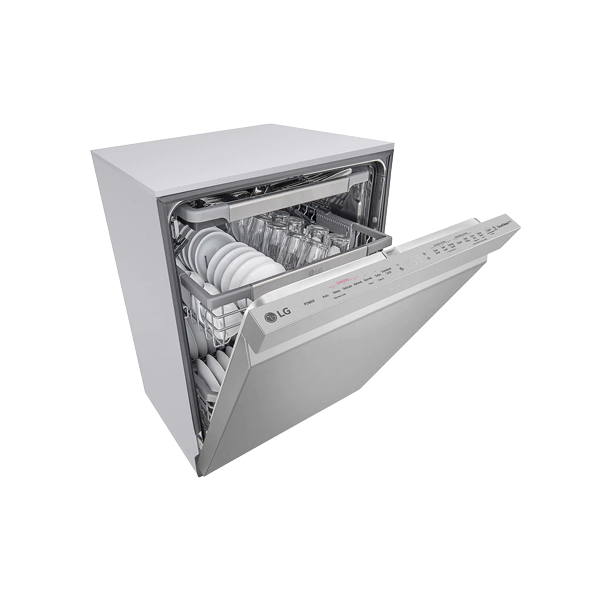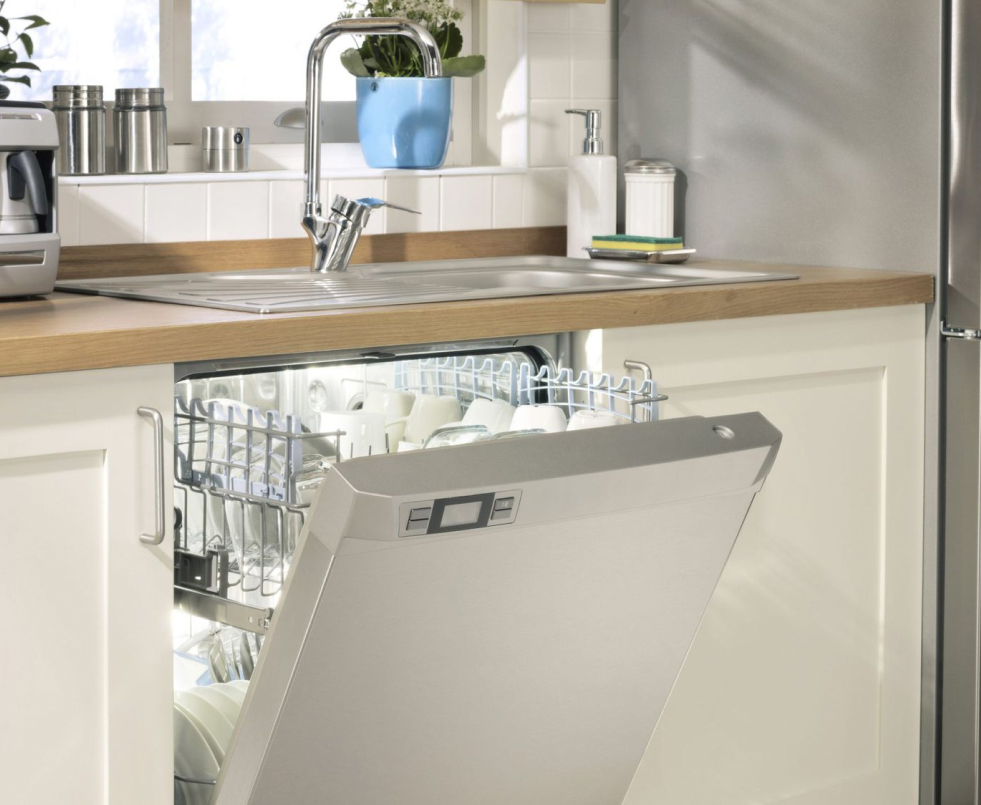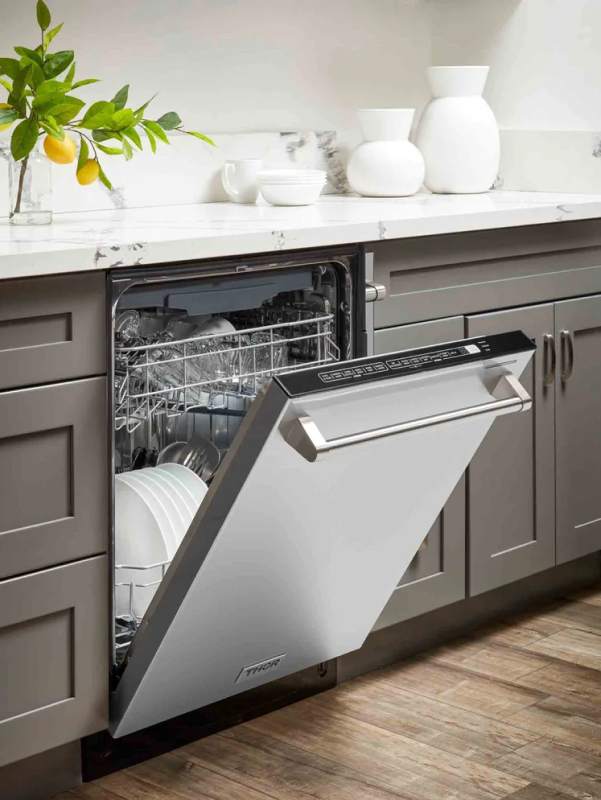Dishwashers have become an indispensable part of modern households, offering unparalleled convenience by relieving us of the monotonous chore of hand-washing dishes.
How Dishwashers Work
Acquiring a comprehensive understanding of inner mechanisms is essential for effective troubleshooting and maintenance. Armed with this knowledge, you can swiftly identify potential issues and determine when it’s prudent to enlist the services of a professional appliance service company. Let’s delve into a meticulous breakdown of how it operates:
Filling
The cycle begins when you select a wash program. The intake valve opens, allowing water from your home’s supply to flow in. A float switch monitors the water level to prevent overflows. Once filled, the heating element at the base raises the water temperature, enhancing detergent effectiveness and eliminating food residues and bacteria.
Washing
Once the water reaches the desired temperature, it dispenses the appropriate detergent amount based on the wash cycle and water hardness. Then, the circulation pump propels soapy water into the spray arms, which spin and distribute water onto dishes, effectively removing food particles. The combination of water pressure and detergent ensures clean dishes
Draining
After the wash cycle, it activates the drain pump to efficiently remove soapy water. It then refills with fresh water for the rinse cycle, aimed at removing any remaining soap residues and loosened food debris. The spray arms rinse the dishes with pure water. Finally, it drains again in preparation for the drying phase.
Drying Process
Drying Methods
Dishwashers use various methods to dry dishes:
- Heating Element: Some use a heating element to warm the air for faster evaporation.
- Residual Heat: Energy-efficient models utilize heat from wash and rinse cycles.
- Fan Dry: Certain models offer a fan dry option for speedy drying, but it may use more energy.
After drying, sound on the signals completion, and your clean dishes are ready for use.
Key Components
To effectively troubleshoot any dishwashing misfortunes and minimize repair cost, it is imperative to familiarize oneself with the key components that constitute this remarkable appliance. This understanding shall empower you to discern potential issues and facilitate fruitful discussions with professional appliance services. Let us embark on a journey of discovery, exploring the crucial elements that shape the dishwasher’s domain:
Wash and Rinse Parts
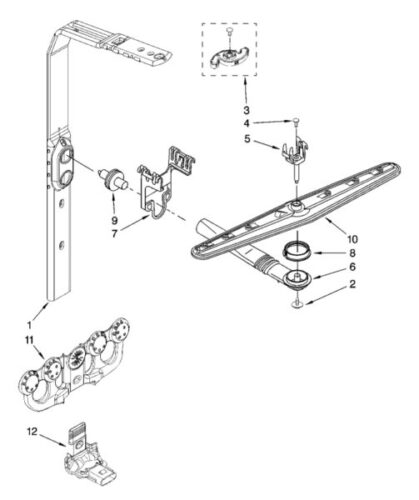
These pivotal components actively participate in the sacred quest for pristine dish cleanliness. Their seamless operation is instrumental in delivering an impeccable washing and rinsing experience. Notable wash and rinse parts encompass:
- Detergent Dispenser: A paramount figure responsible for judiciously releasing detergent at the opportune moment during the wash cycle. If this dispenser falls into disrepair or succumbs to blockage, the optimal dispersion of detergent may be compromised, resulting in lackluster cleaning performance.
- Spray Arms: Majestic guardians of the cleansing ritual, these spinning sentinels orchestrate a symphony of water and detergent distribution throughout the machine. However, if they become obstructed or suffer damage, their noble purpose may be obstructed, impeding the efficient circulation of water and compromising the overall cleaning process. Addressing any issues with the spray arms is crucial to fix performance.
- Filter System: A stalwart defender against the perils of food particles, this diligent system dutifully captures and eliminates unwanted culinary remnants during the wash and rinse cycles. Alas, should the filter succumb to the clutches of clogs or damage, it may impede the cleaning efficacy and potentially lead to draining complications.
Heating Element
The heating element is vital, raising water temperature for effective cleaning and aiding drying by warming the air. If dishes remain damp, the heating element may need attention.
Drying Component
While certain dishwashers rely on the intrinsic heat emanating from the heating element and the natural forces of evaporation to achieve drying prowess, others boast dedicated drying components to elevate this spectacle. These coveted assets can encompass:
- Separate Drying Element: Within select models, a distinct heating element reigns supreme during the drying phase, devoted to intensifying the ambient temperature for enhanced drying efficiency.
- Fan: Many machines proudly boasts an elegant fan, an exquisite maestro orchestrating the symphony of hot air circulation within its hallowed confines. This enchanting airflow dance accelerates the drying process, ensuring swift and sublime results.
Should your dishes persistently bear the damp burden even after the cycle’s denouement, it is possible that an issue plagues one of these esteemed components or the control system governing their harmonious interplay. Promptly addressing any malfunctions in the drying component will help fix drying issues effectively.
Drain System
The drain system noble purpose lies in the resolute evacuation of soiled water at the culmination of each wash and rinse cycle. Prominent figures within the drain system include:
- Drain Pump: This valiant entity propels the dishwater towards freedom, channeling it beyond the threshold and into the bosom of your home’s drainage system. Should this pump falter or succumb to blockage, the drainage might be thwarted, resulting in undue complications.
- Drain Hose: A humble conduit bearing the sacred water, the drain hose dutifully carries the expelled liquid from the drain pump to its final destination within the household drain. However, this conduit is not immune to the whims of fate, as blockages or leaks may emerge, hindering the seamless flow of drainage and causing disruptions along the way. Addressing any issues with the drain hose is vital to fix drainage problems effectively.
By acquainting yourself with the vital components that compose the essence and promptly addressing any problems, you hold the key to unraveling its mysteries and minimizing repair cost. Armed with this knowledge, you can confidently navigate the intricate web of dishwashing intricacies, whether embarking on repairs yourself or engaging in fruitful conversations with seasoned professionals.
Significance of Regular Maintenance and Repair
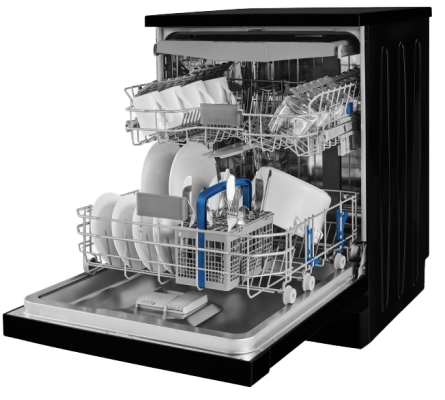
Regular maintenance by a technician is crucial for longevity and peak performance. Over time, issues like mineral buildup, food remnants, and detergent residue can impair its function and lead to problems.
For instance, a clogged filter can be resolved with technician cleaning, preventing motor failure and costly repairs if neglected. Timely technician interventions for minor repairs, such as seal replacement or fixing noisy components, prevent major issues and a possible full replacement.
Prioritizing maintenance and seeking professional help ensures your durability and efficiency, simplifying your dishwashing tasks.
Common Types

This home appliance manifest in a delightful array of designs and dimensions, tailored to accommodate diverse culinary domains and kitchen configurations. While their collective purpose remains steadfast—effortlessly cleansing your cherished dishes—each type boasts distinct features and potential quandaries. Let us embark upon an exploration of the intricacies inherent in the most prevalent types:
Built-in
Built-in models type are indispensable appliances that have revolutionized kitchen cleanup, offering convenience, efficiency, and a touch of modernity. These appliances are seamlessly integrated into kitchen cabinetry, providing a host of benefits for homeowners.
Advantages:
- Space Optimization: They are designed to fit neatly under countertops, saving valuable floor space and making them an excellent choice for kitchens of all sizes.
- Aesthetic Appeal: These home appliance are designed to blend seamlessly with kitchen decor, contributing to a sleek and cohesive appearance.
- Efficient Cleaning: It is equipped with powerful cleaning mechanisms, including multiple spray arms, ensuring thorough cleaning and efficient water and energy use.
- Customization: They come in various sizes, styles, and configurations, allowing homeowners to choose a model that suits their specific needs and kitchen layout.
- Quiet Operation: Many modern built-in models type feature advanced noise reduction technology, ensuring quiet operation that doesn’t disrupt the kitchen environment.
Types of Built-In Models:
- Standard Built-In: These are the most common type, offering a range of features and options to accommodate different dishwashing needs.
- Drawer: Drawer-style consist of one or two separate drawers that can run independently, providing flexibility in washing smaller loads.
- Compact Built-In : Ideal for kitchens with limited space, these smaller units offer the convenience without sacrificing valuable storage.
Considerations:
- Installation: Professional installation is recommended to ensure proper placement, plumbing, and electrical connections.
- Maintenance: Regular cleaning and maintenance are essential to prevent clogs, odors, and to extend lifespan.
- Energy Efficiency: Look for Energy Star-rated models to save on utility costs and reduce environmental impact.
- Loading Capacity: Choose with a suitable loading capacity for your household’s needs.
Double Type
Double, also known as twin, offer an innovative solution for handling your dishwashing needs more efficiently. These appliances come with two separate washing compartments, each capable of running independent dishwashing cycles. Here’s a closer look at what makes double type a valuable addition to your kitchen:
1. Dual Washing Compartments:
The standout feature of double model type is their two washing compartments. This design allows you to wash dishes simultaneously in two separate sections, providing flexibility and convenience.
2. Customized Cleaning:
With two compartments, you can customize your dishwashing routine. For instance, you can run a quick cycle in one compartment for lightly soiled items and a heavy-duty cycle in the other for pots and pans. This adaptability saves time and energy.
3. Ideal for Large Families:
Double model types are particularly beneficial for larger families or households that frequently entertain guests. The increased capacity and flexibility make it easier to manage larger quantities of dishes efficiently.
4. Energy Efficiency:
Despite having two compartments, many double models are designed to be energy-efficient. You can choose to use only one compartment when you have a smaller load, helping to reduce water and energy consumption.
5. Space-Saving Design:
Double model type are designed to fit into standard openings, making them a space-saving alternative to having two separate dishwashers. They offer the convenience of both without requiring extra floor space.
6. Independent Operation:
Each compartment operates independently, which means you can use one while loading or unloading the other. This seamless operation streamlines your dishwashing routine.
7. Quiet Performance:
Many double models come equipped with advanced noise reduction technology, ensuring quiet operation even during heavy use.
Considerations:
- Cost: Double type tend to be more expensive than standard single-drawer models due to their advanced features and capabilities.
- Installation: Ensure that you have the necessary space and plumbing connections to accommodate it . Professional installation may be required.
- Brand and Model: Research and compare different brands and models to find one that suits your specific needs and budget.
- Maintenance: Regular maintenance, such as cleaning filters and checking for clogs, is essential to keep in excellent working condition.
A double type model offers the convenience of two dishwashers in one, making it an excellent choice for larger families, households that frequently entertain guests, or anyone looking for a versatile and efficient solution.
Portable
Portable models are versatile kitchen appliances designed for convenience and flexibility. If you’re looking for an alternative to traditional built-in models or need for a small kitchen, here’s what you should know about portable models:
1. Mobility and Space-Saving:
Portable models are on wheels, allowing you to move them wherever you need them in your kitchen. This mobility is particularly useful if you have limited space or a kitchen layout that doesn’t accommodate built-in appliances.
2. Easy Installation:
You don’t need any special plumbing or wiring to set it up . They typically connect to your kitchen faucet for water intake and use a standard electrical outlet. This makes them an excellent choice for renters or anyone looking for a hassle-free installation.
3. Versatile Sizing:
They come in various sizes to suit different kitchen needs. You can find compact countertop models for smaller kitchens or larger freestanding units with more capacity for bigger households.
4. Convenient Operation:
Operating a portable model is as simple as loading your dishes, connecting it to the faucet, and selecting the desired wash cycle. Many models offer a range of wash programs, including normal, heavy-duty, and eco-friendly options.
5. Energy Efficiency:
They are designed with energy efficiency in mind. They often feature energy-saving modes and water-saving technology, helping you reduce utility bills while being eco-friendly.
6. Effective Cleaning:
Despite their compact size, it deliver thorough cleaning performance. They use similar washing mechanisms to built-in models, including spray arms and detergent dispensers, ensuring your dishes come out sparkling clean.
7. Additional Features:
They may come with features such as delayed start, adjustable racks, and specialized wash cycles for different types of dishes. Some models even have stainless steel interiors for enhanced durability.
8. Easy Maintenance:
Maintenance is relatively straightforward. Regularly cleaning the filters and ensuring proper drainage are essential to keep running smoothly.
Considerations:
- Size: Portable models type come in various sizes, so choose one that best fits your available space and needs.
- Water Connection: Ensure that your kitchen faucet has the appropriate adapter to connect intake hose.
- Storage: Plan for a storage space when it is not in use, as it will need a place to roll away when not needed.
- Capacity: Consider the capacity to ensure it can handle your typical load of dishes.
- Maintenance: Portable units require regular maintenance, such as cleaning filters and inspecting hoses for leaks.
A portable model provides a practical and efficient solution for those who want the benefits without the need for a permanent installation. Whether you have a small kitchen, live in a rental property, or simply prefer the flexibility of a portable appliance, this compact type of model can save you time and effort when it comes to dish cleaning.
Countertop
Countertop model type are the perfect solution for kitchens with limited space or for individuals and small households looking for a convenient and efficient way to clean their dishes. Here’s everything you need to know about these compact kitchen appliances:
1. Space-Saving Design:
They are compact and designed to sit on your kitchen countertop. Their small footprint makes them ideal for apartments, small kitchens, RVs, or as a secondary for larger households.
2. Easy Installation:
They are incredibly easy to install. They typically require a standard electrical outlet and a connection to your kitchen faucet for water intake. There’s no need for complex plumbing or wiring.
3. User-Friendly Operation:
Operating a countertop model is straightforward. Load your dirty dishes, connect it to the faucet, and select the wash cycle. Many models offer multiple wash programs to suit your cleaning needs, including normal, eco, and heavy-duty cycles.
4. Efficient Cleaning:
Don’t be fooled by their small size; they provide effective cleaning. They use similar technology to full-size, including powerful spray arms, detergent dispensers, and adjustable racks to accommodate different dish sizes and shapes.
5. Energy and Water Efficiency:
Modern countertop models are designed with energy and water efficiency in mind. They often feature energy-saving modes and smart water usage technology to reduce both electricity and water consumption.
6. Versatile and Convenient:
They can handle various types of dishes, from plates and glasses to pots and pans. Some models even have dedicated wash cycles for specific items like baby bottles or heavily soiled cookware.
7. Low Maintenance:
Maintenance is minimal. Regularly cleaning the filters and ensuring proper drainage are essential to keep in top working condition.
Considerations:
- Size and Capacity: Evaluate your dishwashing needs to select the right size and capacity. Most models can accommodate around six to eight place settings.
- Compatibility: Ensure that your kitchen faucet is compatible with the connector. Some faucets may require adapters for a secure fit.
- Space Availability: While these dishwashers are compact, you’ll need sufficient countertop space for installation and operation.
- Noise Levels: Some countertop models can be a bit noisy during operation, so consider this factor if you have a noise-sensitive kitchen environment.
They offer a practical and space-saving solution for those who want the convenience without the need for a full-sized built-in model. They are especially useful for renters or people living in small homes. With their ease of installation, efficient cleaning capabilities, and energy-saving features, countertop models make daily dishwashing chores more manageable and less time-consuming.
